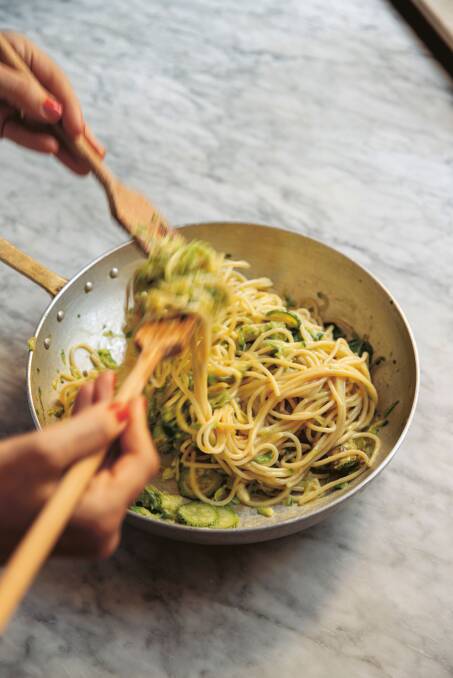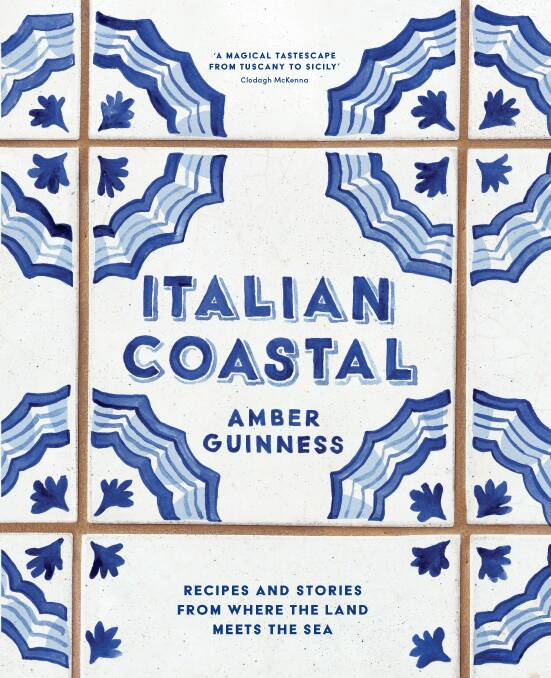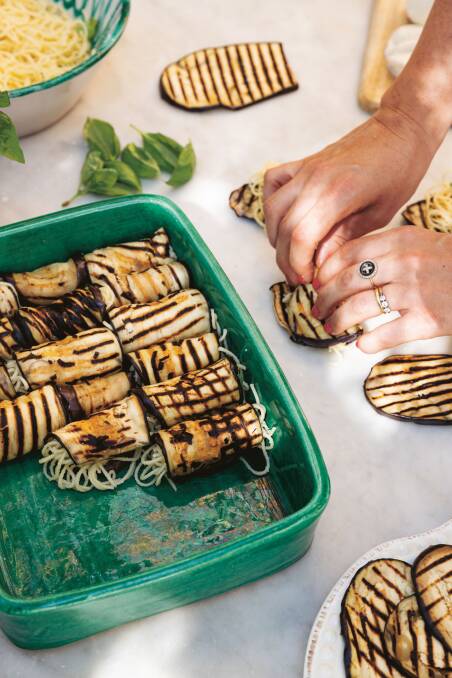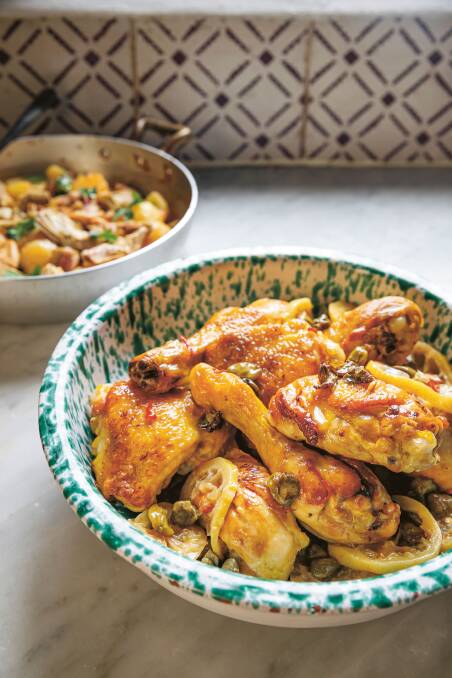Welcome to the Tyrrhenian Sea, home to la dolce vita, sun-drenched islands and seaside towns where even the simplest trattoria has an effortless glamour. Following on from the success of her first book, A House Party in Tuscany, Amber Guinness travels from the Tuscan coast down through Lazio and Campania via Naples and the Amalfi Coast and on to northern Sicily. She delves into the history, stories and flavours that have come home to her kitchen and shaped her food philosophy.

'My' spaghetti with zucchini and basil
This recipe was inspired by the now-famous spaghetti al Nerano of Ristorante Lo Scoglio. It has been one of my favourite dishes ever since I first tried it there years ago, and lots of the seaside restaurants in Marina del Cantone and in nearby Nerano have their own versions too. One reason the original recipe from Lo Scoglio is so indulgent is because they use a variety of cheeses and the zucchini is deep-fried before the sauce is cooked, making it creamy and meaty at the same time. This is great if you are ordering it in a restaurant but a faff to make at home so I have devised a method that gently shallow-fries it instead, using both sliced and grated zucchini. The process is much quicker and results in a lovely meaty texture without needing a deep-fryer.
Ingredients
- 1 kg zucchini
- olive oil, for pan-frying and to serve
- 4 garlic cloves, crushed
- 1/2 tsp chilli flakes
- 1 large bunch of basil, leaves picked and roughly torn
- sea salt and freshly ground black pepper
- 600g spaghetti or linguine
- 150g parmesan, finely grated, plus extra to serve

Method
1. Chop the tops and bottoms off the zucchini and separate into two equal piles. Cut one pile into rounds about 2mm thick. Grate the rest of the zucchini using the large holes of a box grater (if you don't have one, cut into fine matchsticks).
2. Meanwhile, heat four tablespoons of olive oil in a wide frying pan over a medium heat and gently fry the garlic and chilli for a couple of minutes. Once the garlic starts sizzling, add the zucchini discs and toss with the oil and garlic, making sure they are all well coated. Leave the zucchini to fry for five minutes before turning to cook on the other side for a further 10 minutes, tossing occasionally. You want the discs to brown. Add the grated zucchini, basil (reserving a little for garnish), another two tablespoons of olive oil and a generous pinch of salt and pepper. Allow to cook for a further five minutes, then pour in half a glass of water (about 150ml). Reduce the heat and leave to cook gently while you prepare the pasta.
3. Bring a large saucepan of salted water to the boil. Add the pasta, give it a good stir so that it doesn't stick together, and cook until al dente (about nine minutes, but check the packet instructions). Halfway through the pasta cooking time, add a couple of ladlefuls of the starchy pasta water to the zucchini mixture; increase the heat slightly to allow the water to amalgamate into the sauce. Stir in the grated parmesan and another half ladle of pasta water.
4. Drain the pasta (reserving a mugful of the cooking water in case you need it), then add to the zucchini sauce with a drizzle of olive oil and toss to combine. Top with extra parmesan, a few grinds of pepper and the reserved basil. Serve immediately.
Serves 6.
Baked eggplant with pasta, mozzarella and tomatoes

This recipe was taught to me by a woman in Sicily when I was 21. I was a student at the time and couldn't believe the patience it took to complete each step, being much more of an instant gratification sort of cook in those days. But once assembling the involtini (rolls) was under way, it became a pleasantly meditative process. When it came out of the oven it was so delicious that I have never looked back and often make it for gatherings. This dish really benefits from having a very thin pasta, such as angel hair, capellini or vermicelli; linguine works too, but I find it slightly throws off the balance of textures.
Ingredients
- 3 large eggplants
- sea salt and freshly ground black pepper
- 80ml olive oil, plus extra for drizzling
- 1 garlic clove, peeled and lightly squashed with the edge of a knife
- 2 good handfuls of basil leaves
- 2 x 400g tins peeled plum tomatoes
- 200g Capelli d'angelo, capellini, vermicelli or any extremely thin long pasta
- 80g parmesan, finely grated, plus extra to serve
- 3 large balls of fior di latte mozzarella, sliced
Method
1. Trim the ends off the eggplants, then cut lengthways into slices no thicker than 1cm. Sprinkle generously with salt on both sides, place in a colander in the sink and leave for one hour.
2. Meanwhile, heat two tablespoons of olive oil, the garlic, a few basil leaves and a pinch of salt in a large saucepan over a medium heat until gently sizzling. Add the tinned tomatoes, then half-fill the empty tins with water and swish it around to pick up any remaining tomato and pour the tomatoey water into the pan. Gently break up the peeled tomatoes with a wooden spoon. Cook for 30 minutes, stirring occasionally, until the liquid has reduced by a third. Remove and discard the garlic clove. Add an extra drizzle of olive oil and a pinch of salt and set aside.
3. Bring a large saucepan of salted water to the boil. Add the pasta, give it a good stir so it doesn't stick together, and cook for one minute less than the packet instructions specify for al dente (it will finish cooking in the oven). Drain the pasta, and toss it with the remaining 50ml olive oil, a handful of torn basil leaves, the grated parmesan and a pinch of salt and pepper. Set aside until cool enough to handle.
4. Pat the aubergine slices with paper towel to remove any excess moisture. Place a chargrill pan over high heat and let it get piping hot. Working in batches, grill the aubergine slices for about 3 minutes each side until nicely browned with noticeable char lines in the flesh. Transfer the grilled slices to a plate and drizzle with a little extra olive oil. Repeat until you've cooked all the aubergine.
5. Alternatively, spread out the aubergine on a large baking tray lined with baking parchment, brush with olive oil and roast in a preheated 180C fan-forced oven for 25 minutes.
6. Before you assemble the involtini, preheat the oven to 180C fan-forced.
7. Get a medium baking dish that will snugly fit all the involtini (about 30cm x 20cm). Lay a slice of aubergine on a chopping board and put a tablespoon of the pasta in the centre. Roll up the aubergine to enclose the pasta and place it in the dish, tucking the ends together underneath. Repeat with the remaining aubergine and pasta. Cover the parcels with the tomato sauce, and scatter generously with extra parmesan and, if you would like, a few more torn basil leaves. Finish with a layer of mozzarella slices and a little more parmesan. Bake for 15-20 minutes until the mozzarella begins to bubble and brown on top. Leave to rest for five to 10 minutes, then take the dish to the table and invite people to help themselves.
Serves 6.
Chicken with capers, lemon, chillies and thyme

This citrusy chicken recipe is inspired by the flavours I most associate with southern Italy: lemons, chillies, capers and thyme. I like using drumsticks and thighs as these "bone-in" cuts give so much flavour, and, once cooked, you can serve the chicken straight from the pan without needing to do any carving. If you have time, it really is worth marinating the chicken in the fridge overnight as the flavours will be deep and well developed, yielding the tastiest chicken possible.
Ingredients
- 3 tbsp salted or brined capers
- 6 organic chicken drumsticks, skin on
- 6 organic chicken thighs, skin on
- grated zest and juice of 2 lemons
- 100ml olive oil
- 1 generous bunch of thyme, leaves picked
- 2 long red chillies, deseeded and finely chopped
- 6 garlic cloves, peeled and cut in half lengthways
- 3 lemons, sliced into discs
- 250ml white wine
Method
1. If you are using salted capers, soak them for about two hours, changing the water three times. If you don't have time, use brined capers.
2. Prepare the chicken by trimming off any excess skin, then place the pieces in a shallow dish. Add the lemon zest and juice, 50ml olive oil, thyme, chilli, garlic and one tablespoon capers and toss to combine. Cover and leave the marinate in the fridge for at least two hours or overnight.
3. Preheat the oven to 180C fan-forced.
4. Drizzle two tablespoons of olive oil into an ovenproof frying pan. Working in batches so you don't overcrowd the pan, take the chicken pieces out of the marinade, shaking to remove any excess liquid, and then lightly dab with paper towel. Add to the pan and brown on all sides, using tongs to turn the pieces as they brown. As the fat from the chicken begins to melt it can spit, so be careful. As you finish each batch, return the browned chicken to the marinade.
5. Use a spoon to remove any excess fat from the pan until you're just left with a slick of oil.
6. Lay the lemon slices and a tablespoon of capers over the bottom of the pan and place the pieces of chicken neatly on top, ideally in one packed layer. Pour over the marinade juices and the wine, and scatter over the remaining capers.
7. Roast for 20 minutes, then remove from the oven. Carefully tip the pan to one side and, using a serving spoon, scoop up some of the juices and pour them back over the chicken. Roast for another 25 minutes until the chicken is browned and cooked through. Rest for five minutes, then serve with all the delicious cooking juices and your choice of sides.
Serves 6.
Raspberry tiramisu

Tiramisu is probably the best known of all Italian puddings, with its signature combination of coffee, cream and sponge. But across Italy you can find this creamy trifle in more unusual guises, particularly in summer when berries abound. I enjoy overhearing people in the market discussing what they plan to do with their purchases and have often heard someone say the punnet they are holding in their hand is destined for a strawberry or raspberry tiramisu: delicious, fresh and slightly unexpected. This recipe is for one large tiramisu, but you can make individual portions in glasses if you prefer.
Ingredients
- 650g raspberries, rinsed
- juice of 1/2 lemon
- 100ml sweet marsala wine
- 75g caster sugar
- 4 organic egg yolks
- 500g mascarpone
- 3 organic egg whites
- about 24 savoiardi (ladyfinger biscuits)
Method
1. Roughly slice the raspberries in half - some will disintegrate into a jamlike texture, which is fine. Place in a bowl and cover with the lemon juice, marsala and one tablespoon of sugar. Cover and set aside at room temperature for at least one hour or up to overnight in the fridge.
2. Using handheld electric beaters, whisk the egg yolks with the remaining sugar for two to three minutes until thick and pale and the sugar has dissolved. Whisk in the mascarpone and set aside.
3. In a clean metal bowl and with clean beaters, whisk the egg whites to form soft peaks. Be careful not to take it to stiff peaks or the tiramisu will be dry rather than creamy. Gently fold the egg whites into the mascarpone mixture to make a loose velvety cream.
4. By now the steeped raspberries should have released some lovely ruby juices into the wine and lemon juice. Tip them into a small colander over a wide bowl to separate the liquid from the pulp (the bowl should be large enough to dip the biscuits into). Transfer the raspberry pulp to a little bowl.
5. Half dip the biscuits, sugar side down, into the strained raspberry liquid. Cover the bottom of your serving dish with a layer of dipped biscuits, sugar side up, then spoon over a third of the boozy raspberry pulp, spreading it out evenly. Spoon over half the mascarpone cream, smoothing it out with a spatula or the back of a spoon. Repeat with another layer of dipped ladyfingers, half the remaining raspberries and the rest of the mascarpone. Mix together the remaining raspberry pulp and soaking liquid and spoon over the top.
6. Cover and leave in the fridge for at least four to six hours, or overnight so the flavours and textures come together. Remove from the fridge 30 minutes before serving.
Serves 6.


